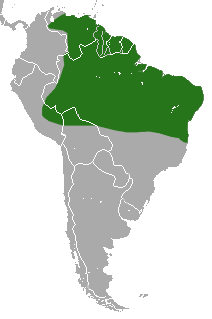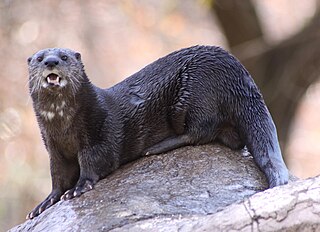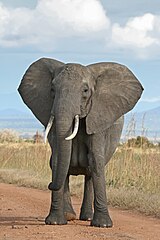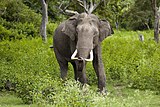
The woolly mouse opossum or long-furred woolly mouse opossum, known locally as the cuíca, is a South American marsupial of the family Didelphidae. Its range includes central Colombia, Venezuela, French Guiana, Guyana, Suriname, eastern Peru, northern Bolivia, and northern Brazil. It was formerly assigned to the genus Micoureus, which was made a subgenus of Marmosa in 2009.

The South American foxes (Lycalopex), commonly called raposa in Portuguese, or zorro in Spanish, are a genus from South America of the subfamily Caninae. Despite their name, they are not true foxes, but are a unique canid genus more closely related to wolves and jackals than to true foxes; some of them resemble foxes due to convergent evolution. The South American gray fox, Lycalopex griseus, is the most common species, and is known for its large ears and a highly marketable, russet-fringed pelt.

Mountain coatis are two species of procyonid mammals from the genus Nasuella. Unlike the larger coatis from the genus Nasua, mountain coatis only weigh 1.0–1.5 kilograms (2.2–3.3 lb) and are endemic to the north Andean highlands in South America.

The striped polecat, also called the African polecat, zoril, zorille, zorilla, Cape polecat, and African skunk, is a member of the family Mustelidae that resembles a skunk. The name "zorilla" comes from the Spanish word "zorillo", meaning "skunk", itself a diminutive form of the Spanish "zorro," "fox." It lives predominantly in dry and arid climates, such as the savannahs and open country of Central, Southern, and sub-Saharan Africa, excluding the Congo basin and the more coastal areas of West Africa.
Harwood's gerbil is distributed mainly in Kenya.

Aonyx is a genus of otters, containing three species, the African clawless otter, the Congo clawless otter, and the Asian small-clawed otter. The word aonyx means "clawless", derived from the prefix a- ("without") and onyx ("claw/hoof").
The silver dik-dik is a small antelope found in low, dense thickets along the southeastern coast of Somalia and in Acacia-Commiphora bushland in the Shebelle Valley in southeastern Ethiopia. It is the smallest species of dik-dik, with a length of 45–50 cm (18–20 in), a height of 30–33 cm (12–13 in), and a weight of 2–3 kg (4.4–6.6 lb). Its back and flanks are grizzled silvery, while the limbs, ears, and muzzle are ochraceus in colour. Little is known about its status, but numbers are believed to be decreasing.

The Abyssinian genet, also known as the Ethiopian genet, is a genet species native to Ethiopia, Eritrea, Somalia, Sudan, and Djibouti. It is listed as Data Deficient on the IUCN Red List. It is one of the least-known genet species.

The Cozumel coati, or Cozumel Island coati, is a coati from the Mexican island of Cozumel, in the Caribbean Sea. It is in the family Procyonidae, which also includes raccoons, olingos, and kinkajous.

The spotted-necked otter, or speckle-throated otter, is an otter native to sub-Saharan Africa.

Johnston's genet is a genet species native to the Upper Guinean forests. As it is threatened by deforestation and conversion of rainforest to agriculturally and industrially used land, it is listed as Near Threatened on the IUCN Red List.

The Gebe cuscus is a species of marsupial in the family Phalangeridae. It is endemic to the island of Gebe, North Maluku province, Indonesia, where it lives at elevations from sea level to 300 m.

The dusky-footed elephant shrew or dusky-footed sengi is a species of elephant shrew in the family Macroscelididae. It is found in Democratic Republic of the Congo, South Sudan, and Uganda. Its natural habitat is subtropical or tropical dry lowland grassland.

The dusky elephant shrew or dusky sengi is a species of elephant shrew in the family Macroscelididae. It is found in Malawi, Mozambique, and Zambia. Its natural habitat is dry savanna.

The elegant water shrew is a species of mammal in the subfamily Soricinae of the family Soricidae. It is the only species within the genus Nectogale. It lives in Sikkim and China.

Thomas's fruit-eating bat, sometimes also popularly called Watson's fruit-eating bat, is a species of bat in the family Phyllostomidae. It is found from southern Mexico, through Central America to Colombia. Its South American range is to the west of the Andes. The species name is in honor of H. J. Watson, a plantation owner in western Panama who used to send specimens to the British Natural History Museum, where Oldfield Thomas would often describe them.

The Asian badger, also known as the sand badger, is a species of badger native to Mongolia, China, Kazakhstan, Kyrgyzstan, the Korean Peninsula and Russia.

The king genet is a small carnivoran native to the Republic of the Congo, Equatorial Guinea, Liberia, Ghana and Côte d'Ivoire. As it has not been recorded since 1946, it is listed as Data Deficient on the IUCN Red List. It probably inhabits only tropical rainforest.

The large myotis is a species of vesper bat. It is found in central and southeast China, Hong Kong, Myanmar, Thailand, and northern Vietnam. It is also expected to occur in northern Laos, but not yet documented there.

The Napo saki, also known as the Napo monk saki, is a species of saki monkey, a type of New World monkey. Its range includes parts of eastern Ecuador and northern Peru. The name is derived from the Napo River in its locality. This species was originally described by Lönnberg as the subspecies Pithecia monachus napensis and has been treated as a synonym of P. monachus monachus. Hershkovitz retained it under P. monachus in 1987, but it was raised to full species status in 2014.


























